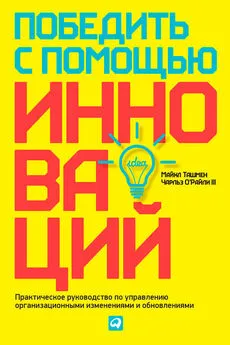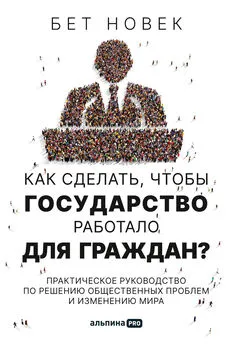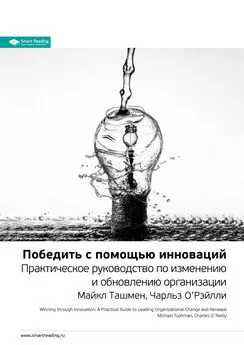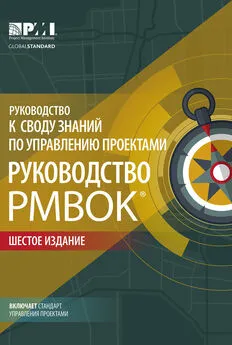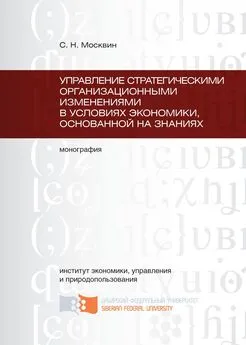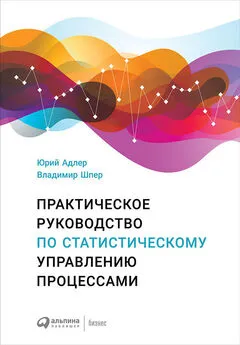Чарльз О'Райли III - Победить с помощью инноваций. Практическое руководство по управлению организационными изменениями и обновлениями
- Название:Победить с помощью инноваций. Практическое руководство по управлению организационными изменениями и обновлениями
- Автор:
- Жанр:
- Издательство:Array Литагент «Альпина»
- Год:2014
- Город:Москва
- ISBN:978-5-9614-3497-2
- Рейтинг:
- Избранное:Добавить в избранное
-
Отзывы:
-
Ваша оценка:
Чарльз О'Райли III - Победить с помощью инноваций. Практическое руководство по управлению организационными изменениями и обновлениями краткое содержание
Победить с помощью инноваций. Практическое руководство по управлению организационными изменениями и обновлениями - читать онлайн бесплатно ознакомительный отрывок
Интервал:
Закладка:
Baum J. and J. Singh. 1994. Evolutionary Dynamics of Organizations. New York: Oxford University Press.
Beer M., R. Eisenstadt and B. Spector. 1990. The Critical Path to Organization Renewal. Boston: Harvard Business School Press.
Bellah R., R. Madsen, W. Sullivan, A. Swidler and S. Tipton. 1985. Habits of the Heart: Individualism and Commitment in American Life. Berkeley: University of California Press.
Biggart N. 1989. Charismatic Capitalization; Direct Selling Organization in America. Chicago: University of Chicago Press.
Boeker W. 1989. Strategic Change: Effects of Founding and History. Academy of Management Journal 32: р. 489–515.
Brass D. and M. Burkhardt. 1993. Potential Power and Power in Use. Academy of Management Journal 36: р. 441–470.
Brown J. 1991. Research that Reinvents the Corporation. Harvard Business Review (January-February): р. 102–111.
Brown. S. and K. Eisenhardt. 1995a. Product Development: Past Research, Present Findings, and Future Directions. Academy of Management Review 20: р. 343–378.
Brown. S. and K. Eisenhardt. 1995b. Product Innovation as Core Capability: The Art of Dynamic Adaptation. Stanford, Calif.: Stanford University Working Paper.
Buckley N. 1994. Break-Out: A New Fashion at Sears. Financial Times. September 28.
Burgelman R. 1991. Intraorganizational Ecology of Strategy Making and Organizational Adaptation. Organization Science 2, no. 3: р. 239–262.
Burgelman R. 1994. Fading Memories: A Process Theory of Strategic Business Exit. Administrative Science Quarterly 39: р. 24–56.
Burgelman R. and R. Rosenbloom. 1989. Technology Strategy: An Evolutionary Perspective. In: R. Rosenbloom and R. Burgelman (eds.), Research on Technological Innovation . Greenwich, Conn.: JAI Press.
Burkhardt M. and D. Brass. 1990. Changing Patterns or Patterns of Change: Effects of Technology Change on Social Network Structure and Power. Administrative Science Quarterly, 35, no. 1: р. 104–127.
Caldwell D. and C. O’Reilly. 1995. Promoting Team-Based Innovation: The Use of Normative Influence. Paper presented at the 54th Annual Meetings of the Academy of Management, Vancouver, B. C., August.
Caminiti S. 1996. Sears Need: More Speed. Fortune, February 13.
Carroll G. and M. Hannan. 1989. Density Dependence in the Evolution of Populations of Newspaper Organizations. American Sociological Review 54: р. 524–541.
Carroll G. and M. Hannan. 1995. Organization in Industries. New York: Oxford University Press.
Chakravarthy B. 1981. Managing Coal. New York: SUNY Press.
Chandler A. 1962. Strategy and Structure. Cambridge, Mass.: MIT Press.
Chandler A. 1990. Scale and Scope. Cambridge, Mass.: Harvard University Press.
Chapman R. 1986. New Dictionary of American Slang. New York: Harper Collins.
Chatman J. 1991. Matching People and Organizations: Selection and Socialization in Public Accounting Firms. Administrative Science Quarterly 36: р. 459–484.
Chatman J. and S. Barsade. 1995. Personality, Organization Culture, and Cooperation. Administrative Science Quarterly 40: р. 423–443.
Christensen C. and J. Bower. 1996. Customer Power, Strategic Investment, and the Failure of Leading Firms. Strategic Management Journal 17, p. 197–218.
Cialdini R. 1993. Influence: The Psychology of Persuasion. New York: Quill Press.
Clark K. and T. Fujimoto. 1991. Product Development Performance. Boston: Harvard Business School Press.
Clark K. and S. Wheelwright. 1992. Organizing and Leading ‘Heavyweight’ Development Teams. California Management Review (Spring): р. 9–27.
Cohen M. and L. Sproul (eds.). 1996. Organizational Learning. London: Sage.
Cohen W. and D. Levinthal. 1990. Absorptive Capacity: A New Perspective on Learning and Innovation. Administrative Science Quarterly 35: р. 128–152.
Collins J. and J. Porras. 1994. Built to Last. New York: Harper Business.
Comer R. and J. Laird. 1975. Choosing to Suffer as a Consequence of Expecting to Suffer: Why Do People Do It? Journal of Personality and Social Psychology 32.
Cooper A. and C. Smith. 1992. How Established Firms Respond to Threatening Technologies. Academy of Management Executive 6, no. 2: р. 55–70.
Cusumano M., Y. Mylonadis and R. Rosenbloom. 1992. Strategic Maneuvering and Mass Market Dynamics: The Triumph of VHS Over Beta. Business History Review (Fall): р. 51–93.
Cusumano M. and R. Selby. 1995. Microsoft Secrets. New York: Free Press.
Damanpour F. 1996. Organizational Complexity and Innovation: Developing and Testing Contingency Models. Management Science 42, no. 5: р. 693–701.
D’Aveni R. 1994. Hypercompetition. New York: Free Press.
David P. 1985. Clio and the Economics of Qwerty. American Economic Review 75 no. 2: р. 332–337.
Davis S. and P. Lawrence. 1977. Matrix. Reading. Mass.: Addison-Wesley.
Day D. 1994. Raising Radicals: Different Processes for Championing Ventures. Organization Science 5: р. 148–172.
De Meyer A. 1991. Tech Talk: How Managers Are Stimulating Global R&D Communication. Sloan Management Review (Spring): р. 49–58.
Deschamps J. and P. Nayak. 1995. Product Juggernauts. Boston: Harvard Business School Press.
Deutschman A. 1994. How HP Continues to Grow and Grow. Fortune, May 2.
Diamond S. 1991. Sears Biggest Problem May Be Its Service. Los Angeles Times, February 2.
Dobrzynski J. 1996. Yes, He’s Revived Sears. But Can He Reinvent It? New York Times, January 7.
Donaldson L. 1995. American Anti-management Theories of Organization. Cambridge, England: Cambridge University Press.
Dosi G. 1982. Technological Paradigms and Technological Trajectories. Research Policy 11: р. 147–162.
Dougherty D. and T. Heller. 1994. The Illegitimacy of Successful Innovation in Established Firms. Organization Science 5: р. 200–218.
Doz Y. and G. Hamel. 1995. The Use of Alliances in Implementing Technology Strategies. In: Y. Doz (ed.), Managing Technology and Innovation for Corporate Renewal . New York: Oxford University Press.
Dumaine B. 1993. Times Are Good? Create a Crisis. Fortune, June 28.
Duncan R. 1976. The Ambidextrous Organization: Designing Dual Structures for Innovation. In: R. Kilman and L. Pondy (eds.), The Management of Organizational Design . New York: North Holland.
Dutton J., L. Fahey and V. Narayanan. 1983. Toward Understanding Strategic Issue Diagnoses. Strategic Management Journal 4: р. 307–323.
Ehrnberg, E. 1995. On the Definition and Measurement of Technological Discontinuities. Technomation 5: р. 437–452.
Eisenhardt K. 1989. Making Fast Strategic Decisions in High Velocity Environments. Academy of Management Journal 32: р. 543–576.
Eisenhardt K. and B. Tabrizi. 1995. Acceleration Adaptive Processes: Product Innovation in the Global Computer Industry. Administrative Science Quarterly 40: р. 84–110.
Ettlie J. and E. Reza. 1992. Organizational Integration and Process Innovation. Academy of Management Journal 35: р. 795–827.
Farnham A. 1993. Mary Kay’s Lessons in Leadership. Fortune, September 20.
Finkelstein S. 1992. Power in Top Management Teams. Academy of Management Journal 35: р. 505–538.
Finkelstein S. and D. Hambrick. 1996. Strategic Leadership: Top Executives and Their Effects on Organizations. New York: West.
Fisher A. 1995. Making Change Stick. Fortune, April 17.
Flatt S. 1993. The Innovation Edge: How Top Management Demography Makes a Difference. Ph. D. diss., University of California, Berkeley.
Florida R. and R. Kenney. 1990. The Breakthrough Illusion. New York: Basic Books.
Fortune. 1991. Today’s Leaders Look to Tomorrow. March 26.
Fortune . 1995. A Conversation with Roberto Goizueta and Jack Welch. December 11.
Foster R. 1986. Innovation: The Attacker’s Advantage. New York: Summit Books.
Foulkes F. 1991. Executive Compensation: A Strategic Guide for the 1990s. Boston: Harvard Business School Press.
Gabarro J. 1987. The Dynamics of Taking Charge. Boston: Harvard Business School Press.
Galbraith J. 1973. Designing Complex Organizations. Reading, Mass.: Addison-Wesley.
Galunic C. and K. Eisenhardt. 1994. Reviewing the Strategy– Structures-Performance Paradigm. In: B. Staw and L. Cummings (eds.), Research in Organization Behavior. Greenwich, Conn.: JAI Press.
Gargiulo M. 1993. Two-Step Leverage: Managing Constraint in Organizational Politics. Administrative Science Quarterly 38: р. 1–19.
Gersick C. 1991. Revolutionary Change Theories: A Multi-Level Exploration of the Punctuated Equilibrium Paradigm. Academy of Management Review 16: р. 1–32.
Gersick C. 1994. Pacing Strategic Change: The Case of New Ventures. Academy of Management Journal 37: р. 9–45.
Glassmeier A. 1991. Technological Discontinuities and Flexible Production Networks: The Case of Switzerland and the World Watch Industry. Research Policy 20: р. 469–485.
Gomory R. 1989. From the Ladder of Success to the Product Development Cycle. Harvard Business Review (November-December): р. 110–115.
Gomory R. 1991. The Technology-Product Relationship: Early and Late Stages. In: N. Rosenberg, R. Landau and D. Mowery (eds.), Technology and the Wealth of Nations . Stanford, Calif.: Stanford University Press.
Gould S. 1987a. The Panda’s Thumb of Technology. Natural History 1: р. 14–23.
Gould S. 1987b. Time’s Arrow, Time’s Cycle. Cambridge, Mass.: Harvard University Press.
Greenwood R. and H. R. Hinings. 1993. Understanding Strategic Change. Academy of Management Journal 6: р. 1052–1081.
Gresov C. 1989. Exploring Fit and Misfit with Multiple Contingencies. Administrative Science Quarterly 34: р. 431–453.
Gresov C., R. Drazin and A. Van de Ven. 1989. Work Unit Uncertainty, Design and Morale. Organization Science 10: р. 45–62.
Grinyer R. and P. McKienan. 1990. Generating Major Change in Stagnating Companies. Strategic Management Journal 11: р. 131–146.
Hambrick D. and R. D’Aveni. 1988. Large Corporate Failures as Downward Spirals. Administrative Science Quarterly 33: р. 1–28.
Hamel G. and C. K. Prahalad. 1989. Strategic Intent. Harvard Business Review, 67: р. 63–76.
Hamel G. and C. K. Prahalad. 1994. Competing for the Future. Boston: Harvard Business School Press.
Hammer M. and J. Champy. 1993. Reengineering the Corporation. New York: Harper Business.
Hannan M. and G. Carroll. 1992. Dynamics of Organizational Populations. New York: Oxford University Press.
Hannan M. and J. Freeman. 1989. Organizational Ecology. Cambridge, Mass.: Harvard University Press.
Haveman H. 1992. Between a Rock and a Hard Place: Organization Change Under Conditions of Fundamental Environment Transformation. Administrative Science Quarterly 37: р. 48–75.
Hays L. 1994. Gerstner Is Struggling to Change Ingrained IBM Culture. Wall Street Journal, May 13.
Henderson R. 1995. Of Life Cycles Real and Imaginary: The Unexpectedly Long Old Age of Optical Lithography. Research Policy 24 (4): р. 631–643.
Читать дальшеИнтервал:
Закладка:
